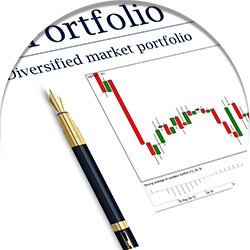How Much is Too Much? Understanding How Much to Hold of Any One Investment
 The emotional and financial scars left by the stock market plunge that decimated so many nest eggs during the economic turmoil of 2008-2009 may have faded, but the lessons from the Great Recession apply as much today as ever. And among the most important lessons of all for investors boils down to a single word: diversification.
The emotional and financial scars left by the stock market plunge that decimated so many nest eggs during the economic turmoil of 2008-2009 may have faded, but the lessons from the Great Recession apply as much today as ever. And among the most important lessons of all for investors boils down to a single word: diversification.
Diversification — that is, maintaining an appropriately balanced mix of assets, including stocks, bonds, cash and other types of assets — is key to growing the value of an investment portfolio while protecting it from the next big market decline, according to financial professionals. Diversification helps mitigate volatility — wild swings in the value of a portfolio. The goal is to give a portfolio a smoother, more predictable ride. That entails diversifying so that instead of moving in lockstep, assets inside a portfolio behave differently enough over time to level out the peaks and valleys in the overall performance of the portfolio.
“The basic premise of diversification is you don’t want to put too many of your eggs in one basket,” explains Kristin C. Sullivan, CFP®, who heads Sullivan Financial Planning in Denver, CO.
Besides diversification, another word that’s good for investors to know: correlation. Correlation is the extent to which investment values move in unison. The more the movements in investment prices track one another, the stronger the correlation between those investments. The goal is to create a portfolio in which assets are non-correlated to some extent. Owning too many correlated assets, with too little diversification, poses danger to an investment portfolio.
“Holding too much of any one investment is a risky bet for the average investor,” says Nicholas Holeman, a Certified Financial Planner™ with Betterment.com in New York City.
So, in the name of diversification, how much should you hold of any one investment, how do you find out exactly how much you own of any single investment, and if it is determined you’re holding more of a single investment than is appropriate to your circumstances and goals, how do you remedy the imbalance? Let’s take those questions one at a time.
1. How much should you hold of any one investment?
One rule of thumb that’s widely used in financial circles is to be sure no more than 5% of an investment portfolio is attributable to a single investment — shares of stock in one company, as an example, or investments in a commodity such as gold, or shares of a mutual fund representing a distinct sector, such as energy or utilities.
That’s more a general guideline than a hard-and-fast rule, notes Sullivan. For instance, the 5% guideline probably would not apply to an investment in a broadly diversified mutual fund, such as an S&P 500 index fund, for example, says Sullivan. Indeed, it isn’t unusual for an investor to allocate 20 or even 30% of a portfolio to an inherently diversified individual investment like that, she notes.
Both Sullivan and Holeman say situations in which a person owns stock in the company for which they work — stock they perhaps accumulated as part of their compensation package — can raise a red flag. “Holding stock in the company you work for can be a big problem,” asserts Holeman. “It can expose you to more risk than you should be taking on,” because not only is your income tied to the company, so, too, is a portion of your assets.
While owning both stocks and bonds is part of a sound diversification strategy for most investors (the proportion of one to the other will differ according to risk profile and other factors), another red flag to watch for is owning both stock and bonds in a single corporation. That’s another instance of potentially putting too many eggs in one basket, according to Sullivan.
2. How do you find out exactly how much you own of any single investment?
Totaling up all your investment assets, then doing some thumbnail calculations to establish the percentage each individual holding represents of the whole — it’s just simple math, right?
Not exactly, says Holeman. Learning how much you own of a single investment isn’t always a straightforward exercise. “What many investors don't even realize is they may have more of the same investment than they think,” he explains. “This is because of something I call ‘false diversification’ and overlapping investments.”
For example, a glimpse at a portfolio might show that shares in the energy company ExxonMobil represent 3% of total portfolio assets. However, what’s not evident, at least at a glance, is that the same portfolio also includes substantial holdings in an energy mutual fund and a broad-based S&P fund, both of which also are substantially invested in ExxonMobil. As a result, that portfolio may be too heavily weighted with ExxonMobil holdings. In such a case, “Their portfolios are more concentrated than they think, and thus more risky,” Holeman says.
For the many investors who own shares in mutual funds, exchange-traded funds (ETFs) and other vehicles made up of multiple individual investments, it takes some digging to learn the make-up of those funds. One relatively easy way to find out, according to Sullivan and Holeman, is to go to Morningstar.com, the investment research site. “You can enter the names of the funds you own, or the ticker symbol for the fund, and the site will ‘X-ray’ into the fund and tell you exactly what it is invested in.”
People who lack the time or the wherewithal to conduct that kind of analysis would be wise to turn to a financial professional, he says. Most have the know-how and the software to analyze an entire portfolio, including individual stocks, ETFs and mutual funds, then provide an analysis of where the portfolio might be over- or under-weighted with its individual holdings.
3. If it is determined you’re holding more of a single investment than is appropriate to your circumstances and goals, how do you remedy the imbalance?
The proper level of diversification should be dictated largely by individual circumstances: stage in life, goals, risk tolerance, etc., says Sullivan.
But because the value of individual investments inside a portfolio are bound to change over time, either positively or negatively, the share each individual investment represents of an overall portfolio will fluctuate, too.
So maintaining the appropriate level of diversification, the right asset mix, requires periodically evaluating all the individual holdings within a portfolio (on an annual basis, at least), then, if the portfolio is deemed to hold too much of one investment, to “rebalance” by allocating less money to that investment and more to others. Rebalancing essentially means moving dollars among various investments inside a portfolio to rectify any imbalance caused by movements in the value of holdings inside the portfolio. Advancing from one life stage to another — such as from work to retirement — also may justify a rebalancing of assets.
Given all the moving parts, and the time and expertise involved in analyzing and rebalancing a portfolio, those are responsibilities that many investors choose to entrust to a financial professional. Someone like a CFP® not only can perform that analysis, they can recommend specific investment vehicles appropriate for a portfolio, whether it’s an index fund, individual stocks or even so-called alternative investments — investment strategies or asset classes that have shown low correlations to traditional stock and bond investments.
To connect with a Certified Financial Planner ™ in your area, visit www.PlannerSearch.org, the Financial Planning Association’s searchable national database of personal finance experts.


